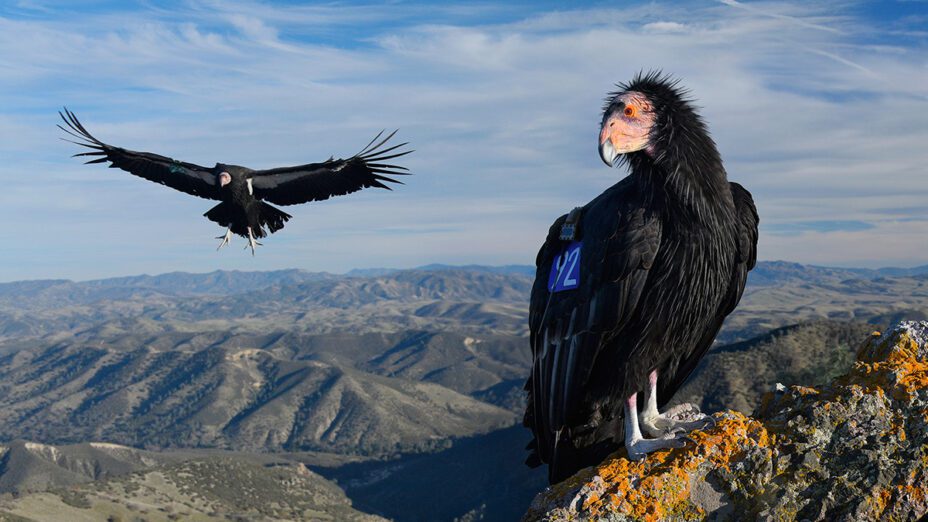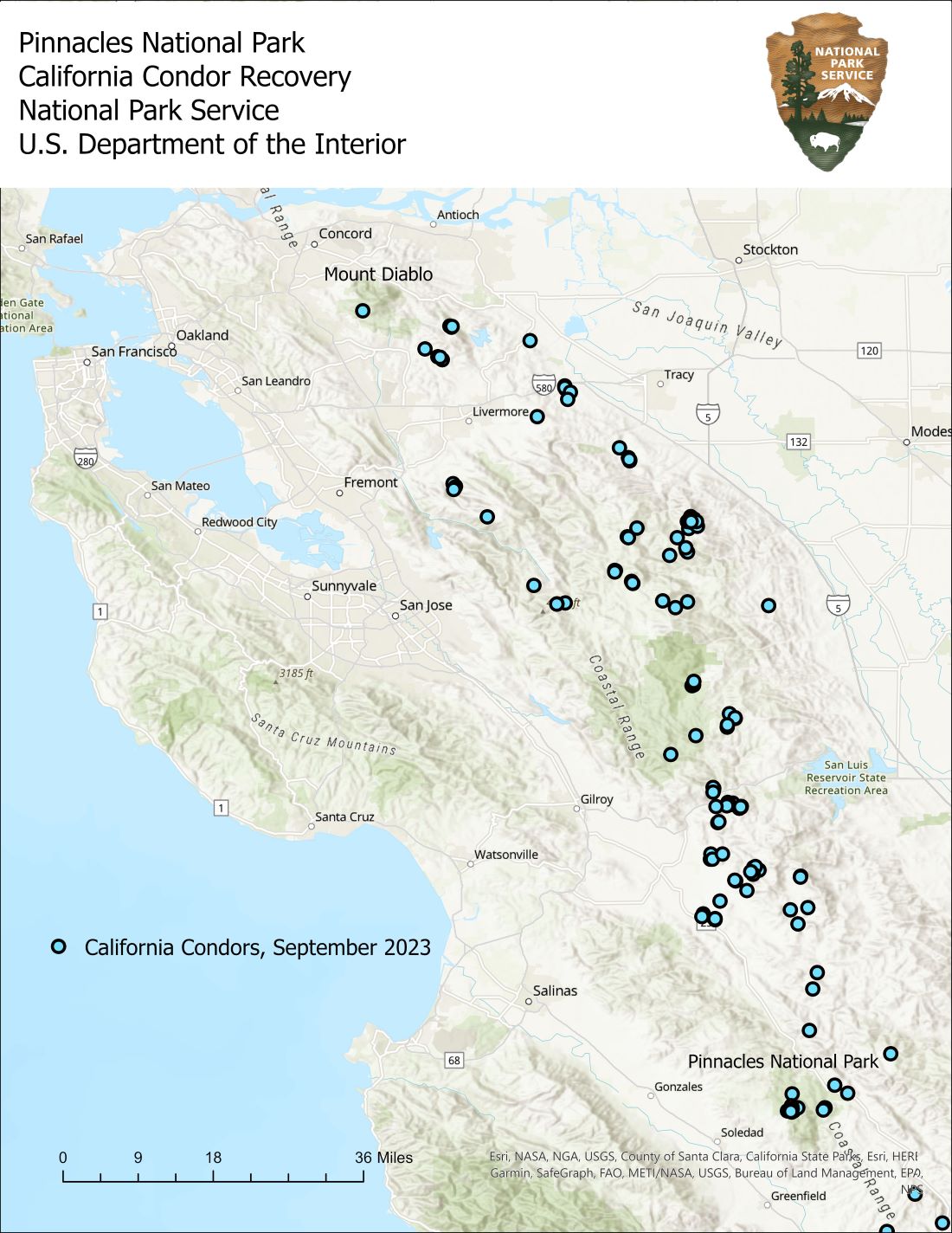
CONTRA COSTA COUNTY AND STANISLAUS COUNTY, CA—Recently, National Park Service staff and volunteers tracked the paths of some special visitors to the Diablo region: California condors! Six condors soared through the skies above Round Valley and Morgan Territory Regional Preserves, one even flying a mile or two west of Mount Diablo’s summit.
“This is amazing news,” said Seth Adams, Save Mount Diablo’s Land Conservation Director. “This is the first flock of California condors to visit Contra Costa in 100 years, and the first record of one flying west of Diablo’s peaks. I started chasing condors 40 years ago and since the recovery program began, I’ve been hoping the birds would reclaim Mount Diablo. Now they are. This kind of good news is happening again and again. But what it really highlights is the importance of the giant Diablo Range as habitat for the birds—200 miles north-south and 3.5 million acres of high-quality intact habitat.”

Over the years, condors have been exploring the northern Diablo Range, lengthening their flights northward as they fly closer and closer to Mount Diablo.
In 2021, a California condor flew into Contra Costa County for the first time in over 100 years, taking an exploratory flight into new territory in the Round Valley–Morgan Territory area.
Last year, another condor was tracked soaring over Brushy Peak Regional Preserve in June, making it the second known California condor in the Mount Diablo area in more than 100 years.
Radio tags or GPS transmitters are placed on all condors, because there are so few, and each one is important to the overall population. The GPS transmitters and subscription service were partially funded by grants from Save Mount Diablo’s Mary Bowerman Science and Research program.
Now six condors, including condors 692, 726, 943, and 1021, have flown close to Mount Diablo in Contra Costa County, spending several hours over Round Valley and Morgan Territory Regional Preserves. Condor 692 flew the closest to Mount Diablo, passing a mile or two west of its summit.
Condor 692 (a 10-year-old male originally released at Pinnacles National Park) and condor 726 (a nine-year-old female originally released in Big Sur) are regularly seen at Pinnacles National Park and have nested there since 2019.
Condor 1021 is a wild-hatched condor that fledged from a nest about 35 miles south of Pinnacles National Park in 2020.
Of the six condors that flew up near Mount Diablo, three have been treated for lead poisoning at some point in their lives. In 2021, Condor 943 was seen with a beer can stuck over his lower beak that he could not get off and made it impossible for him to eat. The biologists at Pinnacles National Park were able to trap him after two and a half weeks and remove the can. This incident reinforced the importance of the Leave No Trace ethic in wild places.
“We are excited to see more California condors from Pinnacles National Park continue to expand their range as they explore Mount Diablo and surrounding mountains. A number of condors are outfitted with GPS trackers and that is how we know when they fly great distances from Pinnacles,” said Alacia Welch, Condor Program Manager for Pinnacles National Park.
According to wildlife biologist Joseph Belli, who volunteers for the California condor recovery program at Pinnacles, this is an exciting year for California condors because there are more birds overall and most of them are young, not quite breeding age. Though condors have been flying north from Pinnacles since 2004, the last few years have seen a significant uptick in their usage of the northern Diablo Range.
“I am starting to notice certain areas they’re paying attention to: Mount Oso and its communication towers, the Sunol and Ohlone regional wilderness areas in southern Alameda County, as well as the Orestimba Wilderness in Henry Coe State Park,” Belli stated. “They also fly near Lick Observatory on Mount Hamilton.”
These flights could be the first step towards the condors expanding their range further north, though it might be years before condors nest in Contra Costa County.
“I think it has to do with exploring and learning a potentially promising new landscape,” added Joseph Belli. “I think the birds are getting to know the area better, and I believe that if the population continues to grow, that will be the key to birds claiming territories north of San Benito County.”
Condors require cavities for nesting, so they look for cliffs, large rocky areas, or mature redwood trees with large hollows. They also require good foraging habitat (relatively undeveloped areas, including rangelands) and water to thrive.
The six condors ended their day by flying back down south to roost on a communications tower at Mount Oso, north of Del Puerto Canyon in Stanislaus County, where several of the other juvenile condors were flying around.
In the 1980s, California condors were nearly extinct. Their population was down to 22 individuals. The biggest threat to them has been lead poisoning in their food. Condors are scavengers and may accidentally ingest lead bullets in carrion.
California condors have had a near miraculous recovery over the past 30 years, having been brought back from the brink of extinction thanks to recovery programs that began releasing condors back into the wild in the 1990s. In 2019, new state regulations took effect in California that make it illegal to use lead ammunition when hunting wildlife throughout the state.
Though California condors are still critically endangered, there are now hundreds living in the wild, and biologists continue to document how they use their range through GPS transmitters or radio tags.
As the California condor population continues its recovery, the California condor’s territory could expand throughout the northern Diablo Range. One day, visitors to Mount Diablo might be able to look up and spot California condors soaring overhead.
Save Mount Diablo
Save Mount Diablo is a nationally accredited, nonprofit land trust founded in 1971 with a mission to preserve Mount Diablo’s peaks, surrounding foothills, watersheds, and connection to the Diablo Range through land acquisition and preservation strategies designed to protect the mountain’s natural beauty, biological diversity, and historic and agricultural heritage; enhance our area’s quality of life; and provide educational and recreational opportunities consistent with protection of natural resources. To learn more, please visit www.savemountdiablo.org.
Image Credits and Captions:
- California condors 692 and 726 that were part of the group that flew north from San Benito County to the northern Diablo Range in early September. Condor 692 flew the closest to Mount Diablo—he passed a mile or two west of the summit. Credit: NPS Photo by Gavin Emmons.
- Map of six California condors’ locations on September 6 and 7, 2023 as tracked by GPS units. Credit: NPS.
Media Contacts:
Seth Adams, Land Conservation Director
Save Mount Diablo
C: 925-381-0905
###

